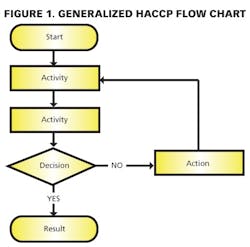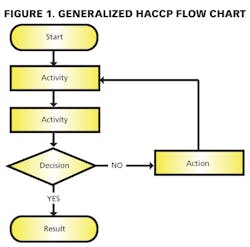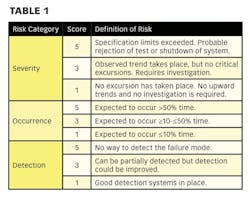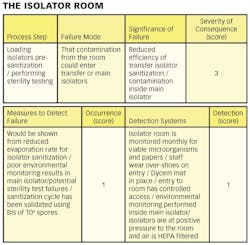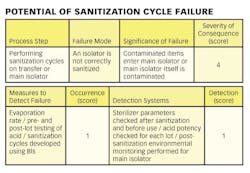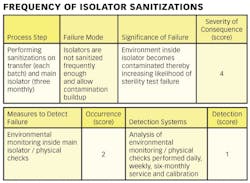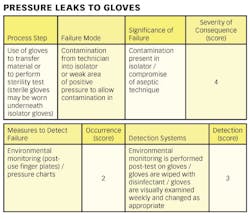Editor
’s Note: The following excerpt is republished from: Saghee, M.R., Sandle, T. and Tidswell, E.C. (Eds.) (2010): Microbiology and Sterility Assurance in Pharmaceuticals and Medical Devices, New Delhi: Business Horizons. Further circulation is prohibited. The book may be purchased at www.businesshorizons.com.For another chapter from the book, read The New Microbiological Technology Wave.
Within microbiology, a shift is taking place from simple laboratory studies toward greater use of risk assessment and management [1]. Sometimes these approaches form part of a drug company's total quality system, sometimes they exist as standalone techniques. The most important guidelines for pharmaceutical microbiology are described in ICH Q9, including the tools of FMEA (Failure Mode and Effects Analysis); FTA (Fault Tree Analysis); and HACCP (Hazard Analysis Critical Control Points).
The two most commonly used within microbiology are HACCP (which originated in the food industry) and FMEA (which was developed for the engineering industry). This article explores these two approaches, first with a description of HACCP, followed by a description and case study of FMEA in sterility testing.
HACCP: Risk Based Approach in Environmental Monitoring
Hazard Analysis and Critical Control Point (HACCP) is a risk assessment approach that addresses physical, chemical, and biological hazards [2]. HACCP is designed so that key actions, known as Critical Control Points (CCPs) can be taken to reduce or eliminate the risk of the hazards being realized. HACCP involves focusing on where the control points in a process are. Once these are established critical limits are set. The critical limits are then monitored and the process is verified as being in control (or not) [3]. There are different variants of HACCP. The “Lifecycle Approach” is similar to that contained in the FDA “Pharmaceutical cGMPs for the 21st Century: A Risk-Based Approach” [4].
There are two key components of HACCP:
• Hazard Analysis: Determining what microbiological, physical, or chemical risks are associated with a process.
• Critical Control Point: A point, step, or procedure at which control can be applied.
In general HACCP involves the following:
1) Conducting a hazard analysis. This involves listing all potential hazards associated with each step, conduct a hazard analysis, and consider any measures to control identified hazards. For this process flows are useful. For example, see Figure 1.
2) Determining the Critical Control Points (CCPs).
3) Establishing critical limit(s).
4) Establishing a system to monitor control of the CCP.
5) Establishing the corrective action to be taken when monitoring indicates that a particular CCP is not under control.
6) Establishing procedures for verification to confirm that the HACCP system is working effectively.
7) Establishing documentation and record keeping.
FMEA score: 3 x 1 x 1 = 3 Risk Evaluation: There is no problem considered from the room environment. Entry to the room is controlled; the sanitization cycle has been challenged with a level of microorganisms far greater than would ever be found in the environment (spores of Geobacillus stearothermophilus); all items entering the Isolator are sanitized (using a chlorine dioxide based sporicidal disinfectant) and the Isolator itself is an effective positive pressure barrier to the outside (at >15 Pascal). As detailed earlier, environmental monitoring is performed inside the Isolator during testing [10]. This monitoring, which has an action level of 1 cfu, is designed to detect any potential contamination inside the Isolator environment.Examination: Potential of Sanitization Cycle FailureFMEA schematic:
FMEA score: 4 x 2 x 3 = 24 Risk Evaluation: This FMEA has been given an occurrence of 2 because weekly checks on the gloves do show, on occasions, holes in gloves. A detection of 3 has been given due to reasons outlined below. The weakest spot on the Isolator is considered to be the glove ports [11] therefore the gloves have been subject to a separate FMEA. Although these are tested after each test using finger plates and are visually inspected by the testing technician pre-test and weekly, such visual checks are unable to detect pin-pricks leading to slow leakage. Pressure monitoring would show a significant leak from torn gloves but is not subtle enough to detect tiny holes [12]. In order to improve detection the organization undertook to purchase a glove-leak tester. This reduced the FMEA score by improving the detection rate from 3 to 1. The probability of contamination is further reduced by the use of aseptic technique by the testing technician at all times. Tests are performed to the same level of aseptic technique that would be provided to performing a sterility test in a clean room. Furthermore all technicians are trained in aseptic technique prior to testing final product for batch release. In addition technicians wear a pair of sterile gloves underneath the Isolator gloves and procedures are in place for an aseptic change of gloves. Spare gloves are held in the Isolator for this purpose. Despite the pre-glove leak testing system FMEA rating of 24—as a possible risk—the exceedingly favorable history of environmental monitoring gives assurance that there is little contamination in the Isolator and no adverse trends. Therefore the gloves are a potential weak spot but this has not been observed in practice. A further weakness is associated with the glove change procedure, which could also be explored as an area for improvement. Other leaks associated with the Isolator also pose a risk and could be similarly examined through FMEA.Summary of Other FMEA ExercisesSeveral other exercises were conducted for this case study, including those for:• Compromise of Isolator Integrity• Connection of Transfer Isolator to Main Isolator and Transfer-in / out of Material• Incomplete Transfer Isolator Sanitization• Failure of a Daily, Weekly or Six-monthly Physical Parameter - HEPA filters / Pressure Leaks to CanopyConclusionIn outlining risk management the chapter has examined some of the risk assessment tools that can be proactively or reactively employed by microbiologists to examine contamination risks. The tools explored in the case studies: FMEA and HACCP are two of the most common. They are not without their limitations and indeed there is no single risk assessment approach applicable to every situation. At times more than one tool will need to be applied and the tools themselves will need to be adapted in order to be appropriate for a given situation. Nevertheless the application of risk assessment is increasingly a key part of pharmaceutical microbiology and the microbiologist is increasingly called upon to use risk assessment as part of contamination control.
References
1. Whyte, W. and Eaton, T. (2004): ‘Microbiological contamination models for use in risk assessment during pharmaceutical production’, European Journal of Parenteral and Pharmaceutical Sciences, Vol. 9, No.1, pp11-15
2. Sidor, L. and Lewus, P. (2007): ‘Using risk analysis in Process Validation’, BioParm International, pp50-57
3. Notermans, S., Barendsz , A. W. and Rombouts, F. (2002): ‘The evolution of microbiological risk assessment in food production’, Foundation Food Micro & Innovation, Netherlands
4. World Health Organisation (2003): Application of Hazard Analysis and Critical Control Point (HACCP) methodology to pharmaceuticals, WHO Technical Report Series No 908, Annex 7, World Health Organisation, Geneva, 2003, link: http://www.who.int/medicines/library/qsm/trs908/trs908-7.pdf
5. De Abreu, C., Pinto, T. and Oliveira, D. (2004): ‘Environmental Monitoring: A Correlation Study Between Viable and Nonviable Particles in Clean Rooms’, Journal of Pharmaceutical Science and Technology, Vol. 58, No.1, January-February 2004, pp45-53
6. The FMEA centre at: http://www.fmeainfocentre.com/introductions.htm
7. Sandle, T. (2003): ‘The use of a risk assessment in the pharmaceutical industry – the application of FMEA to a sterility testing isolator: a case study’, European Journal of Parenteral and Pharmaceutical Sciences, 2003; 8(2): 43-49
8. PDA Technical Report No. 13 (revised): 'Fundamentals of an Environmental Monitoring Programme', September / October 2001
9. EU GMP: 'Rules and Guidance for Pharmaceutical Manufacturers', TSO, UK
10. Farquarharson, G and Whyte, W. (2000): ‘Isolators and Barrier Devices in Pharmaceutical Manufacturing’, PDA Journal of Pharmaceutical Science and Technology, Vol. 54, No.1, January-February 2000, pp33-43
11. Sandle, T. (2004): ‘General Considerations for the Risk Assessment of Isolators used for Aseptic Processes’, Pharmaceutical Manufacturing and Packaging Sourcer, Samedan Ltd, Winter 2004, pp43-47
12. Whipple, A. (1999): ‘Practical validation and monitoring of Isolators used for sterility testing’, European Journal of Parenteral Sciences, 1999, Vol. 4, No.2, pp49-53
